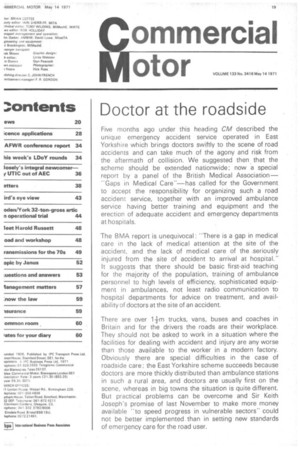ommercial otor
Page 21

If you've noticed an error in this article please click here to report it so we can fix it.
Doctor at the roadside
Five months ago under this heading CM described the unique emergency accident service operated in East Yorkshire which brings doctors swiftly to the scene of road accidents and can take much of the agony and risk from the aftermath of collision. We suggested then, that the scheme should be extended nationwide: now a special report by a panel of the British Medical Association— "Gaps in Medical Care"—has called for the Government to accept the responsibility for organizing such a road accident service, together with an improved ambulance service having better training and equipment and the erection of adequate accident and emergency departments at hospitals.
The BMA report is unequivocal: "There is a gap in medical care in the lack of medical attention at the site of the accident, and the lack of medical care of the seriously injured from the site of accident to arrival at hospital." It suggests that there should be basic first-aid teaching for the majority of the population, training of ambulance personnel to high levels of efficiency, sophisticated equipment in ambulances, not least radio communication to hospital departments for advice on treatment, and availability of doctors at the site of an accident.
There are over 14-m trucks, vans, buses and coaches in Britain and for the drivers the roads are their workplace. They should not be asked to work in a situation where the facilities for dealing with accident and injury are any worse than those available to the worker in a modern factory. Obviously there are special difficulties in the case of roadside care: the East Yorkshire scheme succeeds because doctors are more thickly distributed than ambulance stations in such a rural area, and doctors are usually first on the scene, whereas in big towns the situation is quite different. But practical problems can be overcome and Sir Keith Joseph's promise of last November to make more money available "to speed progress in vulnerable sectors" could not be better implemented .than in setting new standards of emergency care for the road user.




































































































